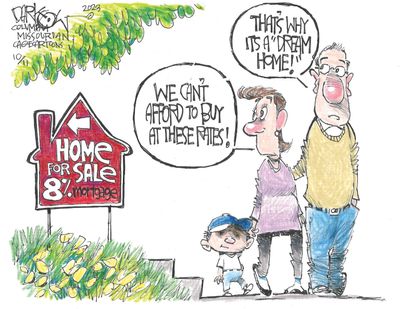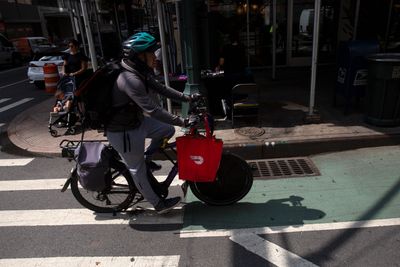by Alexia Stanbridge/Cronkite News, Arizona Mirror
April 13, 2022
WASHINGTON – The U.S. cost of living surged 8.5% over the past 12 months, the fastest one-year increase in more than 40 years, driven by skyrocketing gas, food and housing prices, new government data shows.
And consumers in the Phoenix area have been seeing even sharper increases – while March numbers are not yet available for the Valley, the region saw a one-year inflation rate of 10.9% as of February, according to data from the Bureau of Labor Statistics.
Economists blame the increases on lingering supply chain issues from the pandemic and the energy uncertainty caused by Russia’s invasion of Ukraine. And they don’t expect things to settle down any time soon.
“Hopefully, the supply chains will gradually unscramble and we’ll get back to something more normal,” said George Hammond, an economist at the University of Arizona’s Eller College of Management.
“We don’t really know when that’s going to happen. But … my guess at this point would be some time next year, we’ll see overall inflation start to come down in a pretty significant way,” he said.
The last time inflation was this high was in 1981, and the solution then was a severe tightening of credit that tipped the economy into recession, said Dennis Hoffman, economics professor at Arizona State University.
“I think that the Federal Reserve will step in with massive interest rate increases that will choke off demand for automobiles, choke off demand for houses,” Hoffman said Tuesday. “The interviews six months from now will probably be about. ‘Have we started into a recession, are we headed for recession?’”
Their comments came as new BLS data showed that the consumer price index nationally jumped 1.2% from February to March, capping a 12-month period during which inflation rose 8.5%.
More than half the monthly increase was driven by higher gas prices, according to the BLS, which said higher prices for food, fuel oil, electricity and housing all contributed to the spike in prices over the past year.
The same factors have been in play in the Phoenix-Mesa-Scottsdale area over the past year, the bureau said. The 10.9% rise in inflation from last February to this one was the highest in the nation for that period among large urban areas, according to the data.
Hammond called it the result of a “perfect storm” of economic factors: Increased demand from consumers with money to spend after being stuck at home during the pandemic, running up against limited availability of goods from COVID-19 supply chain problems.
“You know, that’s a real recipe for rapid inflation,” he said.
Hoffman agreed that inflation was bound to rise in an economy where there is “too much money chasing too few goods.”
“We certainly have too few goods, with much of the economy shut down,” Hoffman said. “Much of Asia is still. I mean China is still shut down.”
Both men said the consumer price index took another jump with the Russian invasion of Ukraine, which Hoffman said took “a significant share of oil out of the world market because we have to impose sanctions on Russia.”
Arizona currently has some of the highest gas prices in the nation, at $4.596 per gallon as of Tuesday, according to AAA.
“The Russian invasion of Ukraine has had the effect of really increasing crude oil prices and injecting a lot of uncertainty into the world economy,” Hammond said. “And the rise in crude oil prices has certainly contributed to the increase in overall inflation.”
Arizona consumers face the additional burden of surging housing prices, as the number of homes cannot keep pace with the number of people moving to the state.
“Our population is adding 100,000 residents each year and we have not been able to build quickly enough to keep up,” said David Leibowitz, a spokesperson for the Arizona Multihousing Association, in an email. “The biggest issue right now in Arizona is lack of housing supply.”
Leibowitz said landlords are subject to the same forces as other consumers: Inflation has “driven up the cost of housing people astronomically and driven up the cost of building new units. Add in the supply chain issues that housing businesses are experiencing and you begin to understand why rents have increased.”
Rep. David Schweikert, R-Fountain Hills, said he is not surprised by the demand for housing, given the lure of the state to new residents.
“If I get to choose where I work … wouldn’t you love to live in the Phoenix-Scottsdale area?” Schweikert said during a summit on jobs hosted Tuesday by The Hill newspaper.
But Schweikert said he worries that if inflation does not come down soon, “we’re going to start to see some really uncomfortable numbers on a big segment of our retirement population that, you know, their savings are becoming devalued. So that’s one of my worries there.”
Hoffman said low- or limited-income residents are likely to get hit hardest by inflation.
“You got people living paycheck to paycheck trying to juggle elder care and child care, facing challenges, and they got their landlord telling them that their rents going up $700 a month when the lease expires,” he said. “That is a problem.”
Hammond said the inflation rate will come down – eventually – but that he expects it to “run at a very high rate” in Phoenix and the U.S. for a while. In the meantime, he said, there’s not much consumers can do besides watching their spending.
“The average person can, you know, engage in additional comparative shopping … you can put off purchases you know, as much as you can until prices come back down,” he said.
Hoffman agrees, but said it will be a bitter pill for some consumers to swallow.
“The challenge with inflation is it just is so unkind to certain people that are challenged … to make ends meet, to challenge to pay bills, and really have to take this straight on,” he said.
Arizona Mirror is part of States Newsroom, a network of news bureaus supported by grants and a coalition of donors as a 501c(3) public charity. Arizona Mirror maintains editorial independence. Contact Editor Jim Small for questions: info@azmirror.com. Follow Arizona Mirror on Facebook and Twitter.




